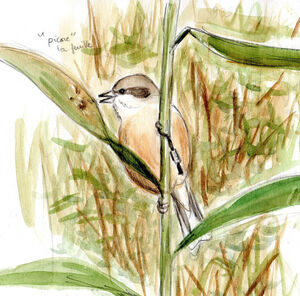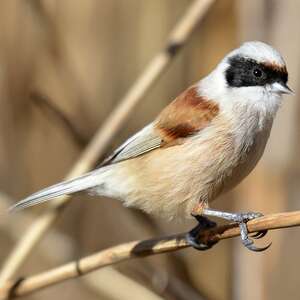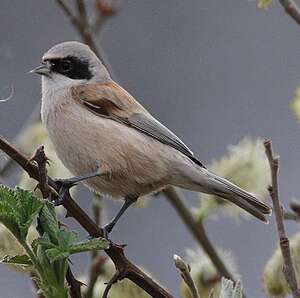Eurasian Penduline Tit
Remiz pendulinus - Rémiz penduline
Identification
It used to be called the Rémiz Blue Tit, but it is not a real tit. It has its own family, the Remizidae, named after the Remiz genus. The Eurasian Penduline Tit is a small bird, slightly smaller than a Blue Tit for example and more slender. Here we will describe the European subspecies pendulinus, one of the 4 that make up the species.
The adult is easy to recognize and sexual dimorphism is slight. The head of the adult male is a very light grey with a black band that starts from the forehead and widens around the eyes and ears. Above the black, a narrow light brown line can be noted on the forehead. The iris is a very dark brown. The beak is triangular and thin from the side view and grey. In the adult female, the grey is darker. The black band is narrower and barely covers the forehead. A one-year old male can be confused with a female.
On the upper parts, the mantle and wings of bright chestnut color, slightly less bright in the female, stand out. The primary and secondary feathers have a wide pale edging.
The lower parts are a more or less pronounced fawn depending on the season. This shade even covers the head in the inter-nuptial season. The strong and clawed feet are dark grey.
The juvenile looks a lot like a winter adult, but with a less vivid upper part and without black on the head. The beak is paler. In the caspius subspecies of SW Russia, the grey on the head is replaced with a warm brown on the crown, slightly lighter on the nape, a brown that is found again on the mantle. The throat is cream. One could think to have another species of Remiz.
Subspecific information 4 subspecies
- Remiz pendulinus pendulinus (Europe to the Ural Mts., Caucasus and w Turkey)
- Remiz pendulinus menzbieri (s and e Turkey and Syria to Armenia and nw Iran)
- Remiz pendulinus caspius (sw Russia and nw Kazakhstan)
- Remiz pendulinus jaxarticus (e Ural Mts. to w Siberia and n Kazakhstan)
Foreign names
- Rémiz penduline,
- Pájaro moscón europeo,
- chapim-de-mascarilha,
- Beutelmeise,
- függőcinege,
- Buidelmees,
- Pendolino,
- pungmes,
- Pungmeis,
- kúdeľníčka lužná,
- moudivláček lužní,
- Pungmejse,
- pussitiainen,
- teixidor eurasiàtic,
- Pungmeisa,
- remiz (zwyczajny),
- somzīlīte,
- plašica,
- Ремез,
- ニシツリスガラ,
- 欧亚攀雀,
- pungmes,
- 歐亞攀雀,
Voice song and call
Habitat
In Europe during the warmer months, the Eurasian Penduline Tit looks for close proximity to freshwater, flowing and still, rich with marsh vegetation (phragmites, typha, carices) surrounded by copses of arboreal species, particularly those that have flexible, drooping branches such as poplars and willows for nesting, but also alders, elms and others.
Behaviour character trait
The Eurasian Penduline Tit is comfortable in wetland and tree vegetation due to its robust legs which allow it to grasp and hold onto stems and even hang upside down.
During mating season, couples select a territory which they defend with their beak and claws. Once the young have left the nest, the families wander in their wetland environment in search of food without seeking the company of other species. It is only at the wintering grounds that Remiz can gather, but never in large numbers, a bit like real tits. Its characteristic shrill cries make it easy to search for specifically.Dietfeeding habits
The Eurasian Penduline Tit is mainly insectivorous in the summer. It feeds on small insects and their larvae, spiders, aphids, caterpillars, especially when raising young.
It also consumes nectar from certain plants such as flowering willows in the spring. In the bad season, it becomes granivorous and looks for small seeds such as those of willows again. It is a classic sight to see them exploring the cattails of Typha, not only for their small seeds, but also for the invertebrates hiding there.Reproduction nesting
The male Eurasian Penduline Tit chooses the tree (willow, poplar, occasionally alder) which will hold the nest, 3 to 15 metres high, and begins building it, calling a female through his continuous cries, but only continues if one comes to collaborate.
In the contrary, he abandons the work and builds somewhere else. The tit's nest is a marvel of architecture. It has the aspect of a pear-shaped pouch 16 cm high and 10 cm in diameter (it is cylindrical or spheroid in reed beds). The bird hangs it from the fork of a flexible branch, above the water. The materials used are vegetal wools, fluffly seeds, intertwined and glued, forming a compact furring which is propped up by twigs and fibres, horsehair and fuzz. The pouch is extended in the upper part by a lateral curved tubular appendix with an entrance turned downwards. This work takes 12 to 14 days.At the end of April or beginning of May, the female, who has fixed the inside of the nest, lays 5 to 10 oblong eggs, usually 7, with a matt white colour and a weight of 0.95 g. She incubates alone during 12 to 15 days, and chases away the male who will be looking to attract a new female for a second nesting; this process is sometimes repeated a third time. The chicks, naked and blind, have an orange throat, bordered in yellow, with a grey-blueish spot on either side. The female feeds them and carries away their droppings. When the young ones have taken flight, the nest is deformed and partly disintegrated. They come back to sleep during 15 to 20 days then leave the area.
Geographic range
The distribution range consists of a Central-European strip extending from the Benelux, East and South France and Spain, to the East by Germany, Poland and Ukraine to the North, Italy, the Balkans and Anatolia to the South, then extending south to Russia and northern Kazakhstan as far as approaching Mongolia.
The winter range is partially disjoint. The Eurasian Penduline Tit leaves the northernmost regions in winter to take refuge in countries bordering the Mediterranean to the north. Further east, it reaches the Aqaba and Persian Gulfs.
Threats - protection
IUCN conservation status
concern
in the Wild
threatened
evaluated
The Eurasian Penduline Tit is not currently threatened. Its range is wide and the habitats it occupies are not highly sought after by humans. It may even be slightly expanding in France. This is not to say we should relax our focus on this interesting species.
Sources of information
- IOC World Bird List (v15.1), Gill, F and D Donsker (Eds). 2025-12-07.
Other sources of interest
 Specification sheet created on
28/10/2023 by Didier Collin with help of Georges Olioso
Specification sheet created on
28/10/2023 by Didier Collin with help of Georges Olioso partially rewritten on 00/00/0000 by Jean François
Translation by AI Oiseaux.net
© 1996-2025 Oiseaux.net
- Accipitriformes
- Aegotheliformes
- Anseriformes
- Apodiformes
- Apterygiformes
- Bucerotiformes
- Caprimulgiformes
- Cariamiformes
- Casuariiformes
- Charadriiformes
- Ciconiiformes
- Coliiformes
- Columbiformes
- Coraciiformes
- Cuculiformes
- Eurypygiformes
- Falconiformes
- Galliformes
- Gaviiformes
- Gruiformes
- Leptosomiformes
- Mesitornithiformes
- Musophagiformes
- Nyctibiiformes
- Opisthocomiformes
- Otidiformes
- Passeriformes
- Pelecaniformes
- Phaethontiformes
- Phoenicopteriformes
- Piciformes
- Podargiformes
- Podicipediformes
- Procellariiformes
- Psittaciformes
- Pterocliformes
- Rheiformes
- Sphenisciformes
- Steatornithiformes
- Strigiformes
- Struthioniformes
- Suliformes
- Tinamiformes
- Trogoniformes

































